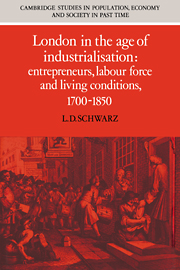Book contents
- Frontmatter
- Contents
- List of figures
- List of tables
- Acknowledgements
- List of abbreviations
- Introduction
- Part I Wealth and occupations in London
- Part II Fluctuations and mortality in the metropolis
- Part III The standard of living and the London trades
- 6 The making of a wage rate
- 7 The challenge of sweated labour: a tale of four trades
- 8 The defences of the inferior artisans
- Conclusion: downstream from industrialisation
- Appendices
- Bibliography
- Index
- Cambridge Studies in Population, Economy and Society in Past Time
6 - The making of a wage rate
Published online by Cambridge University Press: 11 September 2009
- Frontmatter
- Contents
- List of figures
- List of tables
- Acknowledgements
- List of abbreviations
- Introduction
- Part I Wealth and occupations in London
- Part II Fluctuations and mortality in the metropolis
- Part III The standard of living and the London trades
- 6 The making of a wage rate
- 7 The challenge of sweated labour: a tale of four trades
- 8 The defences of the inferior artisans
- Conclusion: downstream from industrialisation
- Appendices
- Bibliography
- Index
- Cambridge Studies in Population, Economy and Society in Past Time
Summary
The wage: concept and reality
When examining the higher ranks of the professions, especially government service, during the seventeenth and most of the eighteenth centuries, one looks in vain for the concept of a regular salary that was supposed to reflect the hours of work and was all that a person received by way of remuneration. ‘It was not the salary of any place that did make a man rich but the opportunity of getting money while he is in the place’ was the advice that persuaded Pepys to become secretary of the Navy Board, while until the end of the eighteenth century it was customary for persons in the Crown's employment who paid out money to be given a commission of about 1 per cent by the receiver of the payment, a practice quite different from bribery. In 1788 the Head Clerk of the office of the Navy Comptroller had a salary of only £240 but fees of £1,737; in 1781 he had received as much as £2,510 in fees. There was also a wide range of ad hoc payments: during the 1730s the Doorkeeper of the Court of Chancery was paid 10s. for every case heard, but 2s. of this went to the Usher of the Rolls, 2s. 6d. to the Cryer, 1s. to the Lord Chancellor's Tipt-Staff and the Registrar's Bagbearer, while the Master of the Rolls' Tipt-Staff and the Court Keeper each received 6d.
- Type
- Chapter
- Information
- London in the Age of IndustrialisationEntrepreneurs, Labour Force and Living Conditions, 1700–1850, pp. 161 - 178Publisher: Cambridge University PressPrint publication year: 1992



